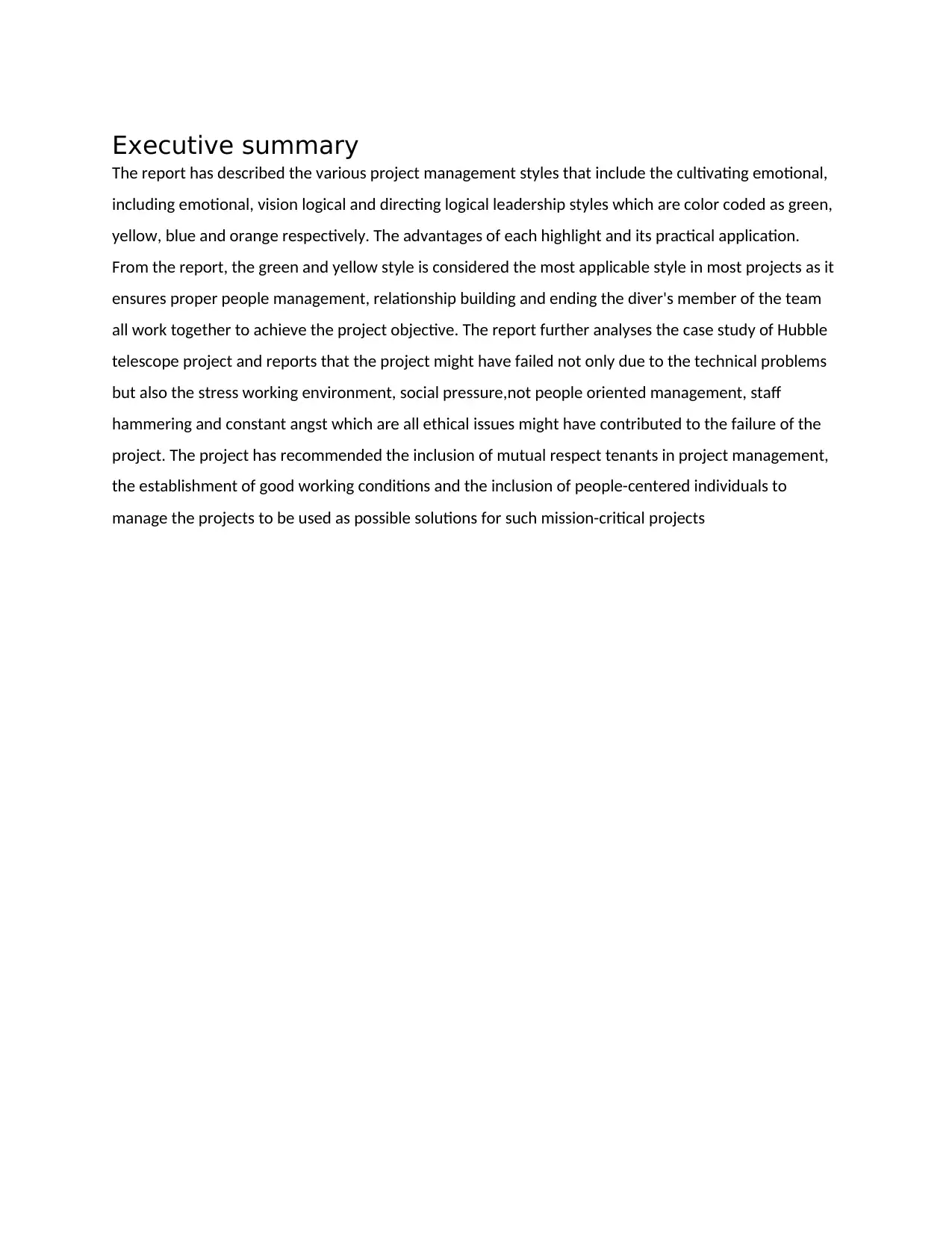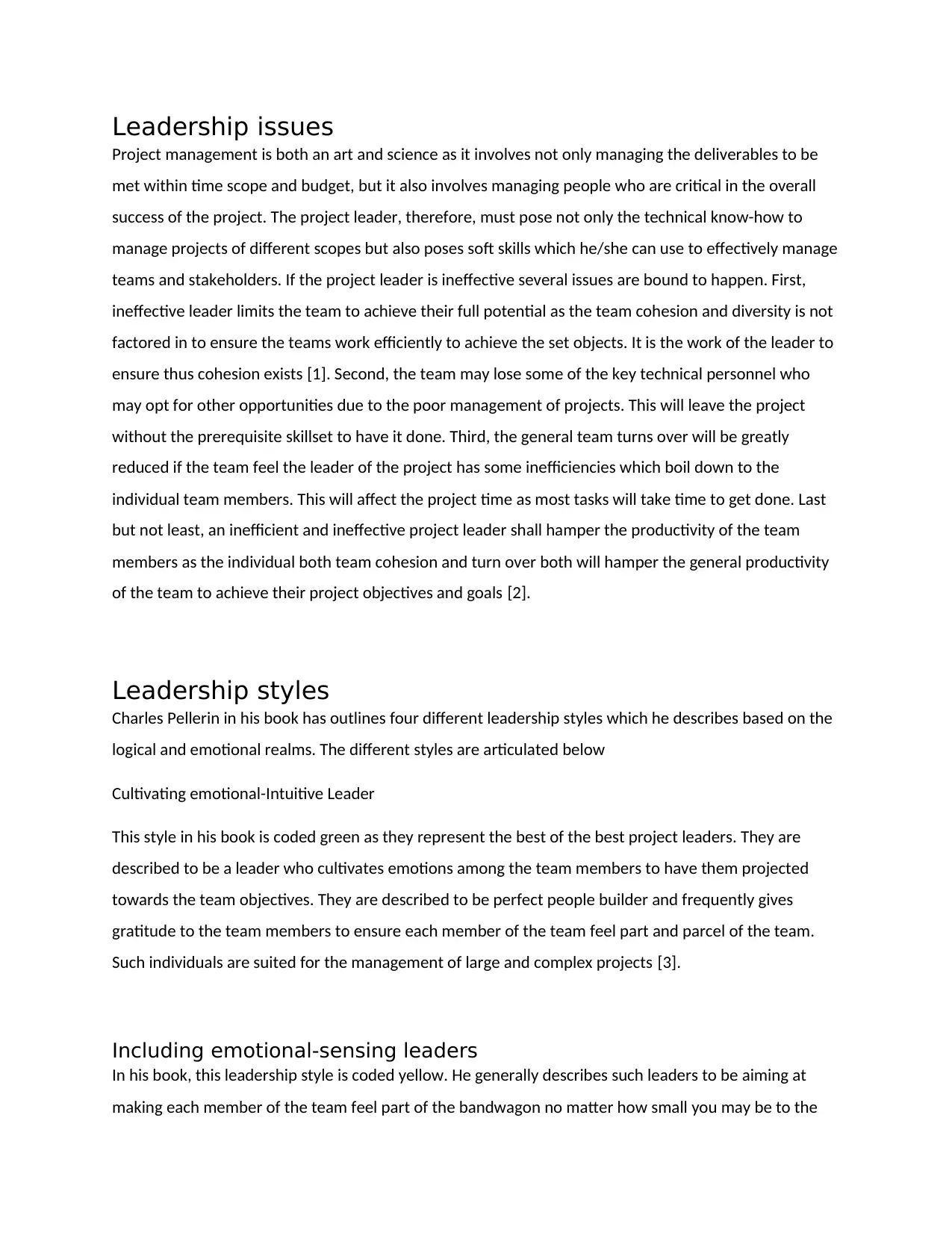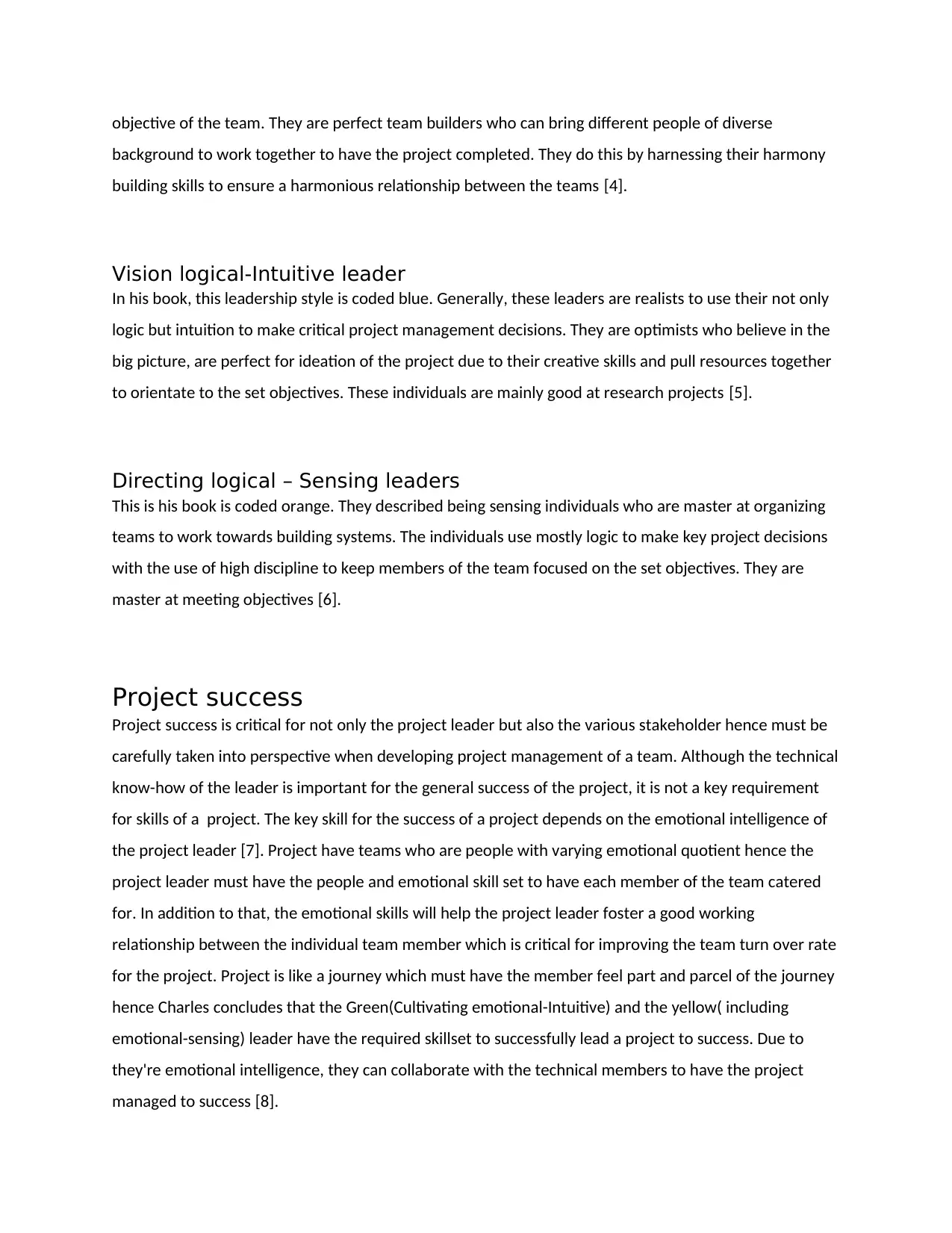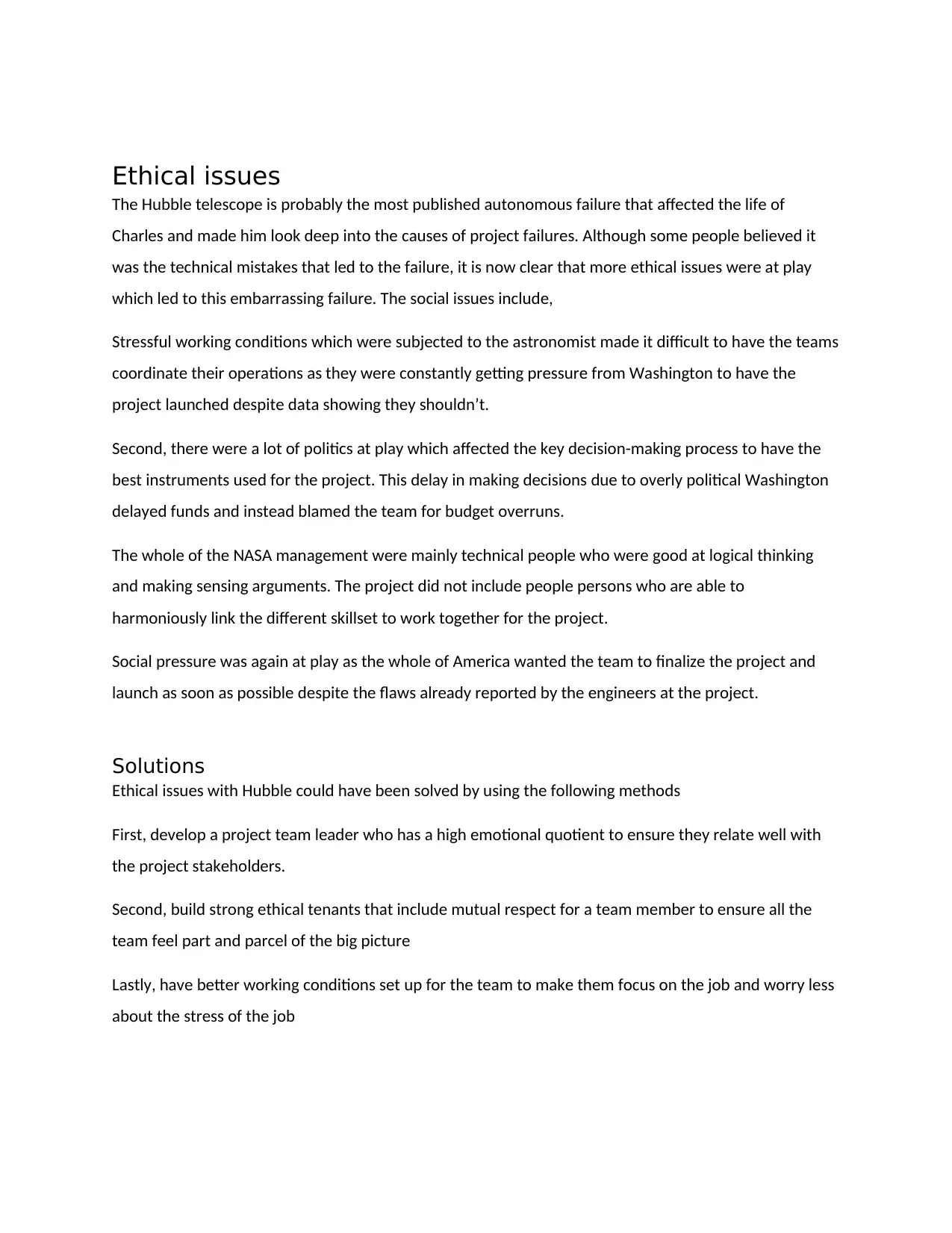MN601 T1 2019: Case Study on Project Management Leadership and Ethics
VerifiedAdded on 2023/01/18
|6
|1637
|42
Case Study
AI Summary
This case study examines various project management leadership styles, including cultivating emotional, including emotional, vision logical, and directing logical styles, and their practical applications. The report highlights the importance of green and yellow leadership styles for people management and relationship building. It analyzes the Hubble telescope project as a case study, suggesting that ethical issues such as stressful working environments and poor people-oriented management contributed to its failure. The report recommends implementing mutual respect, establishing good working conditions, and incorporating people-centered leaders to improve project outcomes, especially in mission-critical projects. The study emphasizes the significance of emotional intelligence in project leaders and its impact on team cohesion, turnover, and overall project success. The report also addresses ethical concerns and proposes solutions to foster a positive work environment and improve project outcomes.

Executive summary
The report has described the various project management styles that include the cultivating emotional,
including emotional, vision logical and directing logical leadership styles which are color coded as green,
yellow, blue and orange respectively. The advantages of each highlight and its practical application.
From the report, the green and yellow style is considered the most applicable style in most projects as it
ensures proper people management, relationship building and ending the diver's member of the team
all work together to achieve the project objective. The report further analyses the case study of Hubble
telescope project and reports that the project might have failed not only due to the technical problems
but also the stress working environment, social pressure,not people oriented management, staff
hammering and constant angst which are all ethical issues might have contributed to the failure of the
project. The project has recommended the inclusion of mutual respect tenants in project management,
the establishment of good working conditions and the inclusion of people-centered individuals to
manage the projects to be used as possible solutions for such mission-critical projects
The report has described the various project management styles that include the cultivating emotional,
including emotional, vision logical and directing logical leadership styles which are color coded as green,
yellow, blue and orange respectively. The advantages of each highlight and its practical application.
From the report, the green and yellow style is considered the most applicable style in most projects as it
ensures proper people management, relationship building and ending the diver's member of the team
all work together to achieve the project objective. The report further analyses the case study of Hubble
telescope project and reports that the project might have failed not only due to the technical problems
but also the stress working environment, social pressure,not people oriented management, staff
hammering and constant angst which are all ethical issues might have contributed to the failure of the
project. The project has recommended the inclusion of mutual respect tenants in project management,
the establishment of good working conditions and the inclusion of people-centered individuals to
manage the projects to be used as possible solutions for such mission-critical projects
Paraphrase This Document
Need a fresh take? Get an instant paraphrase of this document with our AI Paraphraser

Leadership issues
Project management is both an art and science as it involves not only managing the deliverables to be
met within time scope and budget, but it also involves managing people who are critical in the overall
success of the project. The project leader, therefore, must pose not only the technical know-how to
manage projects of different scopes but also poses soft skills which he/she can use to effectively manage
teams and stakeholders. If the project leader is ineffective several issues are bound to happen. First,
ineffective leader limits the team to achieve their full potential as the team cohesion and diversity is not
factored in to ensure the teams work efficiently to achieve the set objects. It is the work of the leader to
ensure thus cohesion exists [1]. Second, the team may lose some of the key technical personnel who
may opt for other opportunities due to the poor management of projects. This will leave the project
without the prerequisite skillset to have it done. Third, the general team turns over will be greatly
reduced if the team feel the leader of the project has some inefficiencies which boil down to the
individual team members. This will affect the project time as most tasks will take time to get done. Last
but not least, an inefficient and ineffective project leader shall hamper the productivity of the team
members as the individual both team cohesion and turn over both will hamper the general productivity
of the team to achieve their project objectives and goals [2].
Leadership styles
Charles Pellerin in his book has outlines four different leadership styles which he describes based on the
logical and emotional realms. The different styles are articulated below
Cultivating emotional-Intuitive Leader
This style in his book is coded green as they represent the best of the best project leaders. They are
described to be a leader who cultivates emotions among the team members to have them projected
towards the team objectives. They are described to be perfect people builder and frequently gives
gratitude to the team members to ensure each member of the team feel part and parcel of the team.
Such individuals are suited for the management of large and complex projects [3].
Including emotional-sensing leaders
In his book, this leadership style is coded yellow. He generally describes such leaders to be aiming at
making each member of the team feel part of the bandwagon no matter how small you may be to the
Project management is both an art and science as it involves not only managing the deliverables to be
met within time scope and budget, but it also involves managing people who are critical in the overall
success of the project. The project leader, therefore, must pose not only the technical know-how to
manage projects of different scopes but also poses soft skills which he/she can use to effectively manage
teams and stakeholders. If the project leader is ineffective several issues are bound to happen. First,
ineffective leader limits the team to achieve their full potential as the team cohesion and diversity is not
factored in to ensure the teams work efficiently to achieve the set objects. It is the work of the leader to
ensure thus cohesion exists [1]. Second, the team may lose some of the key technical personnel who
may opt for other opportunities due to the poor management of projects. This will leave the project
without the prerequisite skillset to have it done. Third, the general team turns over will be greatly
reduced if the team feel the leader of the project has some inefficiencies which boil down to the
individual team members. This will affect the project time as most tasks will take time to get done. Last
but not least, an inefficient and ineffective project leader shall hamper the productivity of the team
members as the individual both team cohesion and turn over both will hamper the general productivity
of the team to achieve their project objectives and goals [2].
Leadership styles
Charles Pellerin in his book has outlines four different leadership styles which he describes based on the
logical and emotional realms. The different styles are articulated below
Cultivating emotional-Intuitive Leader
This style in his book is coded green as they represent the best of the best project leaders. They are
described to be a leader who cultivates emotions among the team members to have them projected
towards the team objectives. They are described to be perfect people builder and frequently gives
gratitude to the team members to ensure each member of the team feel part and parcel of the team.
Such individuals are suited for the management of large and complex projects [3].
Including emotional-sensing leaders
In his book, this leadership style is coded yellow. He generally describes such leaders to be aiming at
making each member of the team feel part of the bandwagon no matter how small you may be to the

objective of the team. They are perfect team builders who can bring different people of diverse
background to work together to have the project completed. They do this by harnessing their harmony
building skills to ensure a harmonious relationship between the teams [4].
Vision logical-Intuitive leader
In his book, this leadership style is coded blue. Generally, these leaders are realists to use their not only
logic but intuition to make critical project management decisions. They are optimists who believe in the
big picture, are perfect for ideation of the project due to their creative skills and pull resources together
to orientate to the set objectives. These individuals are mainly good at research projects [5].
Directing logical – Sensing leaders
This is his book is coded orange. They described being sensing individuals who are master at organizing
teams to work towards building systems. The individuals use mostly logic to make key project decisions
with the use of high discipline to keep members of the team focused on the set objectives. They are
master at meeting objectives [6].
Project success
Project success is critical for not only the project leader but also the various stakeholder hence must be
carefully taken into perspective when developing project management of a team. Although the technical
know-how of the leader is important for the general success of the project, it is not a key requirement
for skills of a project. The key skill for the success of a project depends on the emotional intelligence of
the project leader [7]. Project have teams who are people with varying emotional quotient hence the
project leader must have the people and emotional skill set to have each member of the team catered
for. In addition to that, the emotional skills will help the project leader foster a good working
relationship between the individual team member which is critical for improving the team turn over rate
for the project. Project is like a journey which must have the member feel part and parcel of the journey
hence Charles concludes that the Green(Cultivating emotional-Intuitive) and the yellow( including
emotional-sensing) leader have the required skillset to successfully lead a project to success. Due to
they're emotional intelligence, they can collaborate with the technical members to have the project
managed to success [8].
background to work together to have the project completed. They do this by harnessing their harmony
building skills to ensure a harmonious relationship between the teams [4].
Vision logical-Intuitive leader
In his book, this leadership style is coded blue. Generally, these leaders are realists to use their not only
logic but intuition to make critical project management decisions. They are optimists who believe in the
big picture, are perfect for ideation of the project due to their creative skills and pull resources together
to orientate to the set objectives. These individuals are mainly good at research projects [5].
Directing logical – Sensing leaders
This is his book is coded orange. They described being sensing individuals who are master at organizing
teams to work towards building systems. The individuals use mostly logic to make key project decisions
with the use of high discipline to keep members of the team focused on the set objectives. They are
master at meeting objectives [6].
Project success
Project success is critical for not only the project leader but also the various stakeholder hence must be
carefully taken into perspective when developing project management of a team. Although the technical
know-how of the leader is important for the general success of the project, it is not a key requirement
for skills of a project. The key skill for the success of a project depends on the emotional intelligence of
the project leader [7]. Project have teams who are people with varying emotional quotient hence the
project leader must have the people and emotional skill set to have each member of the team catered
for. In addition to that, the emotional skills will help the project leader foster a good working
relationship between the individual team member which is critical for improving the team turn over rate
for the project. Project is like a journey which must have the member feel part and parcel of the journey
hence Charles concludes that the Green(Cultivating emotional-Intuitive) and the yellow( including
emotional-sensing) leader have the required skillset to successfully lead a project to success. Due to
they're emotional intelligence, they can collaborate with the technical members to have the project
managed to success [8].
⊘ This is a preview!⊘
Do you want full access?
Subscribe today to unlock all pages.

Trusted by 1+ million students worldwide

Ethical issues
The Hubble telescope is probably the most published autonomous failure that affected the life of
Charles and made him look deep into the causes of project failures. Although some people believed it
was the technical mistakes that led to the failure, it is now clear that more ethical issues were at play
which led to this embarrassing failure. The social issues include,
Stressful working conditions which were subjected to the astronomist made it difficult to have the teams
coordinate their operations as they were constantly getting pressure from Washington to have the
project launched despite data showing they shouldn’t.
Second, there were a lot of politics at play which affected the key decision-making process to have the
best instruments used for the project. This delay in making decisions due to overly political Washington
delayed funds and instead blamed the team for budget overruns.
The whole of the NASA management were mainly technical people who were good at logical thinking
and making sensing arguments. The project did not include people persons who are able to
harmoniously link the different skillset to work together for the project.
Social pressure was again at play as the whole of America wanted the team to finalize the project and
launch as soon as possible despite the flaws already reported by the engineers at the project.
Solutions
Ethical issues with Hubble could have been solved by using the following methods
First, develop a project team leader who has a high emotional quotient to ensure they relate well with
the project stakeholders.
Second, build strong ethical tenants that include mutual respect for a team member to ensure all the
team feel part and parcel of the big picture
Lastly, have better working conditions set up for the team to make them focus on the job and worry less
about the stress of the job
The Hubble telescope is probably the most published autonomous failure that affected the life of
Charles and made him look deep into the causes of project failures. Although some people believed it
was the technical mistakes that led to the failure, it is now clear that more ethical issues were at play
which led to this embarrassing failure. The social issues include,
Stressful working conditions which were subjected to the astronomist made it difficult to have the teams
coordinate their operations as they were constantly getting pressure from Washington to have the
project launched despite data showing they shouldn’t.
Second, there were a lot of politics at play which affected the key decision-making process to have the
best instruments used for the project. This delay in making decisions due to overly political Washington
delayed funds and instead blamed the team for budget overruns.
The whole of the NASA management were mainly technical people who were good at logical thinking
and making sensing arguments. The project did not include people persons who are able to
harmoniously link the different skillset to work together for the project.
Social pressure was again at play as the whole of America wanted the team to finalize the project and
launch as soon as possible despite the flaws already reported by the engineers at the project.
Solutions
Ethical issues with Hubble could have been solved by using the following methods
First, develop a project team leader who has a high emotional quotient to ensure they relate well with
the project stakeholders.
Second, build strong ethical tenants that include mutual respect for a team member to ensure all the
team feel part and parcel of the big picture
Lastly, have better working conditions set up for the team to make them focus on the job and worry less
about the stress of the job
Paraphrase This Document
Need a fresh take? Get an instant paraphrase of this document with our AI Paraphraser

References
[1] B. Allan, The No-Nonsense Guide to Project Management. London: Facet Publishing, 2017.
[2] J. Cunningham, J. Salomone, and N. Wielgus, “Project Management Leadership Style: A Team
Member Perspective,” International Journal of Global Business, vol. 8, no. 2, pp. 27–54, Dec. 2015.
[3] P. Eskerod and A. L. Jepsen, Project Stakeholder Management. Burlington, VT: Routledge, 2013.
[4] I. Huertas-Valdivia, A. R. Gallego-Burín, and F. J. Lloréns-Montes, “Effects of different leadership
styles on hospitality workers,” Tourism Management, vol. 71, pp. 402–420, Apr. 2019.
[1] B. Allan, The No-Nonsense Guide to Project Management. London: Facet Publishing, 2017.
[2] J. Cunningham, J. Salomone, and N. Wielgus, “Project Management Leadership Style: A Team
Member Perspective,” International Journal of Global Business, vol. 8, no. 2, pp. 27–54, Dec. 2015.
[3] P. Eskerod and A. L. Jepsen, Project Stakeholder Management. Burlington, VT: Routledge, 2013.
[4] I. Huertas-Valdivia, A. R. Gallego-Burín, and F. J. Lloréns-Montes, “Effects of different leadership
styles on hospitality workers,” Tourism Management, vol. 71, pp. 402–420, Apr. 2019.

[5] T. Kendrick, The Project Management Tool Kit : 100 Tips and Techniques for Getting the Job Done
Right, vol. Third edition. New York: AMACOM, 2014.
[6] R. Müller and J. R. Turner, Project-Oriented Leadership. Farnham, Surrey [England]: Routledge, 2010.
[7] M. L. Springer, Project and Program Management : A Competency-Based Approach, vol. 2nd ed.
West Lafayette: Purdue University Press, 2013.
[8] M. H. Trentim, Managing Stakeholders As Clients : Sponsorship, Partnership, Leadership, and
Citizenship. Newtown Square, Pa: Project Management Institute, 2013.
Right, vol. Third edition. New York: AMACOM, 2014.
[6] R. Müller and J. R. Turner, Project-Oriented Leadership. Farnham, Surrey [England]: Routledge, 2010.
[7] M. L. Springer, Project and Program Management : A Competency-Based Approach, vol. 2nd ed.
West Lafayette: Purdue University Press, 2013.
[8] M. H. Trentim, Managing Stakeholders As Clients : Sponsorship, Partnership, Leadership, and
Citizenship. Newtown Square, Pa: Project Management Institute, 2013.
⊘ This is a preview!⊘
Do you want full access?
Subscribe today to unlock all pages.

Trusted by 1+ million students worldwide
1 out of 6
Related Documents
Your All-in-One AI-Powered Toolkit for Academic Success.
+13062052269
info@desklib.com
Available 24*7 on WhatsApp / Email
![[object Object]](/_next/static/media/star-bottom.7253800d.svg)
Unlock your academic potential
Copyright © 2020–2025 A2Z Services. All Rights Reserved. Developed and managed by ZUCOL.





